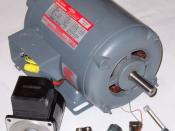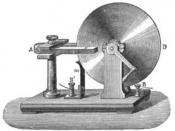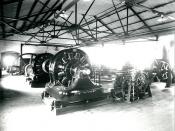An electric generator is basically an electric motor working backwards. An electric motor converts electrical energy into mechanical energy, and an electric generator converts mechanical energy into electrical energy. An electric generator looks almost identical to an electric motor. Each consists of a loop that is able to rotate in a magnetic field. The electric motor uses electrical energy to make the loops rotate which creates mechanical energy. In the electric generator it uses mechanical energy to make the loops spin resulting in the creation of electric current within the loop.
The way an electric generator functions is based on the principal of "electromagnetic induction". Electro magnetic induction is when you move a wire through a magnetic field causing electric current to enter the wire. As long as the magnet and the coil move relative to each other, a potential difference is produced across the coil and current flows in the coil.
A potential difference is also produced if the magnetic field through the coil grows stronger or weaker. The greater the rate at which the magnetic force through the coil changes, the greater the potential difference is produced. The key is that the magnetic field through the coil must be changing. Michael Faraday, an English scientist, and Joseph Henry of the United States independently proved this theory in 1831.
Electric generators have many uses. Extremely large generators are used by electrical utilities to generate power for their main power grids. When you are selecting a generator you should select a generator with a power rating higher than you need. That way you won't have to run it at full load because it is bad for efficiency, and rough on the machine. The power ratings of an electric generator are based on the ability for the owner to overcome generator...


